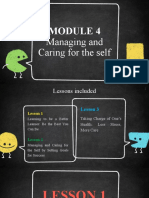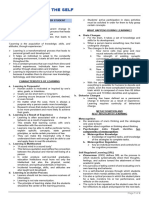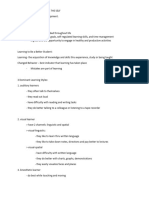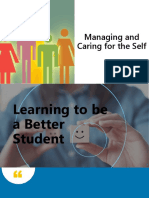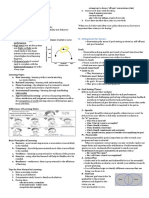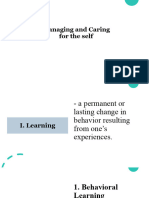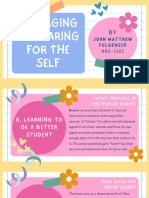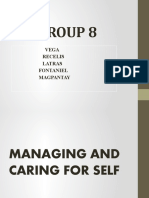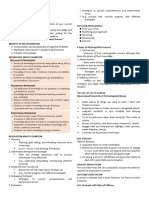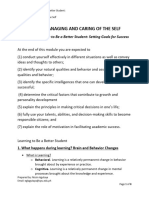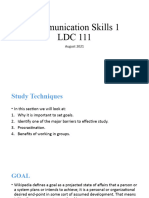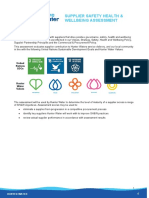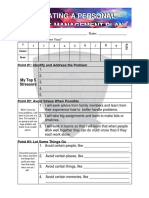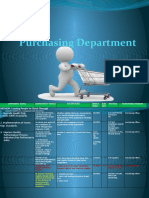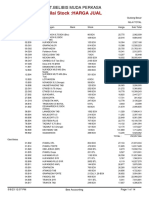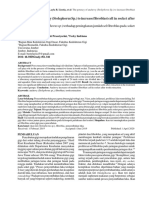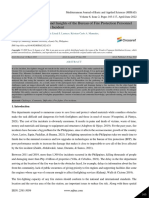Understanding The Self
Uploaded by
angelina.kang2000charUnderstanding The Self
Uploaded by
angelina.kang2000charUNDERSTANDING THE SELF
○ Knowledge encountered most often is more likely to be
recalled.
UNIT 3 - MANAGING THE SELF
● Vividness
○ Learning is proportional to the vividness of the
LEARNING TO BE A BETTER STUDENT process.
● Exercise
Learning refers to a change in potentiality that results from ○ Using what has been learned will increase its likelihood
experience. of being recalled.
● Readiness
Learning Types ○ Readiness to learn is proportional to the efficiency of
● Rote Learning learning.
○ Learning without understanding
○ E.g. Memorization Stress and Performance
● Rational Learning
○ Learning with understanding
● Motor Learning
○ Adaptation of movement to stimuli relating to speed
and precision of performance
○ E.g. Sports
● Associational Learning
○ Learning through establishing relationships
○ E.g., raising a dog
● Appreciational Learning
○ Acquiring attitudes, ideas, satisfaction, and judgment
concerning values, as well as the recognition of worth
and importance, which the learner gains from
activities.
Basic Principles of Learning Low degree of stress Low performance
● Recency
○ Most recent impression or association is more likely to Moderate degree of stress Highest performance on tasks
be recalled.
● Frequency
FIRST YEAR, SECOND SEMESTER FINALS
UNDERSTANDING THE SELF
● Physiological
High degree of stress Fight-or-flight response and less
○ Intake
brain activity in the cortical
○ Time-of-day energy
areas.
○ Mobility vs passivity
○ Perceptual preferences
Creating a Neural Pattern ■ Primary grade children are often auditory,
Neurons, also called nerve cells, send and receive signals or shifting to visual and kinesthetic in late
information between different areas of the brain and the entire body. elementary years, then moving to visual and
auditory in adolescence and adulthood.
Practice Makes Permanent ● Environmental
Pinball machine analogy ○ Light
● Faint Pattern ○ Sound
○ When you first begin to understand something. ○ Design
○ The neural pattern is there, but weak. ○ Temperature
● Darker Pattern ● Emotional
○ When you try to solve the problem again from a fresh ○ Affect
start, without looking at the solution. ○ Motivation
○ You begin deepening that neuron pattern. ○ Persistence
● Darkest Pattern ○ Responsibility
○ When you can go over each step of solving a problem ● Social
completely and concisely in your mind, and have ○ Alone
practiced on related problems. ○ In a pair
○ You deepened and strengthened that neuron pattern, ○ With peers
making learning permanent. ○ With an adult
Building Strong Neural Structures Personality Types and Learning Styles
● Strong and deepened neural network Myers-Briggs Type Indicator or MBTI
○ Spaced Repetition ● Extraversion vs Introversion
○ A little every day ○ Focus on outer (E) OR inner word (I)
● Weak neural network ● Sensing vs Intuition
○ Cramming ○ Focus on taking basic information (S) or interpreting
○ All at once and adding meaning (N)
● Thinking vs Feeling
Differences in Learning Styles
FIRST YEAR, SECOND SEMESTER FINALS
UNDERSTANDING THE SELF
○ Focus on logic and consistency (T) or people and ● Students Retaining
circumstances (F) ○ 10% of what they read
● Judging vs Perceiving ○ 20% of what they hear
○ Focus on getting things decided (J) or staying open to ○ 30% of what they see
new information or options (P) ○ 50% of what they hear and see
○ 70% of what they say
Procrastination ○ 90% of what they say and do
● An act of unnecessary but intentional (can be habitual)
delaying or postponement of tasks. What do you do when you just can’t figure something out?
● Response to a temporal negative feeling state. ● Sleep on it
● Leads to poor academic performance and emotional ○ Sleep has also been shown to make a remarkable
discomfort difference in your ability to figure out difficult
● Not a problem of time management but rather of motivation. problems and to understand what you're trying to
learn.
Why do students procrastinate? ● Shift to a diffuse mode of thinking
● Task Aversion ○ It is like letting the problem or whatever you are
○ Less willing to do something we do not want to do (an learning to “simmer” and move into easier tasks.
unwelcome or a difficult task).
● Uncertainty Are GOALS important?
○ Creates the need for upfront and costly planning ● A guide to act
before a task. ○ Determines what you want to do and where you want
● Fear of Failure to go.
○ Fear of making a mistake puts pressure to make the ● Motivates one’s behavior
best possible choice. ○ Energizes people to move.
● External Structure ○ No goal = no motivation
○ Diversion of other tasks, social events or temptations, ○ Gives direction and purpose
peer influence, amount of other appointments.
Goal Setting Theory (Edwin Locke and Gary Latham)
Here’s the trick! Goal setting is essentially linked to task performance.
● Pomodoro Technique ● Specific
○ 25 minutes ○ Clear and specific.
○ No interruptions ○ Narrow and targets a specific area.
○ Focus ● Measurable
○ Reward ○ Measure the results of your goal.
FIRST YEAR, SECOND SEMESTER FINALS
UNDERSTANDING THE SELF
● Action Plan
○ Show the steps you will take to achieve your goal.
● Realistic or relevant
○ Adds meaning to life.
○ Applicable to the present situation and aligned with the
vision you have set.
● Time Limit
○ Every goal needs a deadline to motivate and help
focus.
○ Helps in preventing everyday tasks from taking priority
over your goals.
Goals are associated with human needs
Self-Efficacy (Albert Bandura)
● Some goals are driven by the deepest desires of the self.
● Overall belief in one’s ability to succeed in life, specifically the
● Maslow’s Hierarchy of Needs
ability to overcome challenges and complete a task
successfully.
● Strong, positive relationship between self-efficacy and success
= Higher self-efficacy, higher success rate.
Growth Mindset Theory (Carol Dweck)
● There are two categories that can group individuals based on
their behavior, specifically their reaction to failure.
○ Growth Mindset
■ Abilities are acquired through effort and
studying.
■ “Okay lang kung mag-fail, basta may
matutunan.”
○ Fixed Mindset
■ Abilities are innate
○ “Being arranged in a hierarchy of prepotency”
■ Interprets failure as the lack of necessary basic
■ Must be satisfied or mostly satisfied before
abilities.
higher-level needs become activated.\
■ “Ayaw ko na. Okay na ‘to.”
The Bridge to Yet
FIRST YEAR, SECOND SEMESTER FINALS
UNDERSTANDING THE SELF
● Understanding that you are on a learning curve ○ Too much pressure or trauma, and you are unable to
● Embracing challenges and engaging with them cope with it
● Processing and correcting errors, not running away from them ● Eustress
● Praising the process: focus, effort, strategy, and perseverance. ○ Positive stress
○ Acceptable levels of stress help you to focus better and
achieve your goals.
SETTING GOALS FOR SUCCESS
Goal Categories of Stressors
● Representation of desired states, where states are broadly ● Environment
construed as outcomes, events, or processes. ○ Overcrowding
● Future-oriented, multidimensional, and displays the property ○ Unsafe living conditions
of equifinality ○ Pollution
○ A goal can be achieved in multiple ways. ○ Extreme temperature
● From higher-order goals to smaller subgoals and even goals ● Lifestyle
under a specific dimension are organized in a hierarchical ○ Poor diet
pattern. ○ Substance use and abuse
● May change because of the importance-commitment factor: ○ Lack of exercise or sleep
○ How relevant the goal is ● Psychological
○ How long an individual is willing to strive for a specific ○ Negative self-talk
goal. ○ Perfectionism
○ Pessimism
UNIT 4 - CARING FOR THE SELF ○ Unrealistic Expectation
● Financial
○ Debt
○ Unexpected Expense
STRESS
○ Limited funds
Stress ● Life Event
● Internal alarm system in response to a real or perceived threat ○ Death of a loved one
● A combination of a stressor and a stress response ○ Job loss
● Can be useful or harmful, energizing or exhausting. ○ Marriage
○ Birth of a child (even on positive events)
Types of Stress ● Interpersonal
● Distress ○ Conflicts with family or friends
○ Negative stress ○ Isolation
FIRST YEAR, SECOND SEMESTER FINALS
UNDERSTANDING THE SELF
○ Discrimination
● Work or School
○ Heavy workload
○ Deadlines
○ Job insecurity
○ Academic pressure
● Physiological
○ Illness
○ Injury
○ Hormonal change
○ Chronic pain
General Adaptation Syndrome (Hans Selye)
● How your body and mind react is your stress response. The
nervous and endocrine systems become active during the
body’s response to stressors.
● The body’s response:
○ Largely involuntary or automatic
○ Happens in three stages — Alarm, Resistance, and ● Alarm Stage
Exhaustion (ARE) ○ Detects a stressor and prepares the body to either
○ Occurs whether the stress is physical or emotional, confront (fight) or escape (flight).
positive or negative ● Resistance Stage
● There is no specific time frame for each stage of the GAS, as ○ Adapts to the stressor to restore physiological balance,
duration varies based on several factors such as the nature of but still expends high energy as cortisol remains
the stressor and individual factors. elevated.
● Exhaustion Stage
Stages of GAS ○ Body resources are depleted after prolonged exposure
to the stressor. Overwhelmed and can no longer
maintain resistance.
Symptoms of Stress
Anger or Frustration Anxiety Decreased Sex Drive
FIRST YEAR, SECOND SEMESTER FINALS
UNDERSTANDING THE SELF
● Type C
Fatigue Headaches Indigestion
○ Lydia Temoshok
Nail Biting Over or Under-Eating Procrastination ○ Introverts and Stress-prone
○ Tend to be very pleasant and try to keep the peace
Social Withdrawal Teeth Grinding Worry ○ Finds it difficult to express emotions, especially
negative ones.
Drug or Alcohol Use
● Type D
Muscle Tension ○ Henry Dreher
○ Love routines and follows orders
Sleep Difficulties ○ Tendency to experience increased negative emotions
across time and situations.
Other ○ Tends not to share negative emotions with others,
because of fear of rejection or disapproval.
Basic Needs Neglected When Stressed
Social and Cultural Dimensions of Stress among Filipinos
Sleep Exercise
Stress (Tensiyon) ay isang emosyonal at pisikal na reaksiyon sa
Personal Hygiene Managing Addictions pagbabago.
● Exposure to a stressful event or environment
Healthy Diet Medical Adherence ● Negative physical and psychological outcomes
● Physical illness and poor mental health
Social or Love Needs Other
The Compliant Filipino
Stress and Personality Types ● “Hiya”
● Type A ○ Filipinos are very aware and wary of the opinions of
○ Meyer Friedman others and what people think of them.
○ Self-driven and Competitive ● Utang na Loob
○ Competitive, high-achieving personality type. ○ Debt of gratitude
○ Most likely to develop heart disease or other significant ○ Causes stress as it refutes unconditional positive
health problems. regard.
● Type B ● Pakikisama
○ Ray Rosenman ○ The pressure to conform can cause stress
○ Charismatic and Easy-going
○ “Laid back”, non-competitive personality type Filipino Social Values
○ Less likely to suffer from heart disease. ● Karangalan
FIRST YEAR, SECOND SEMESTER FINALS
UNDERSTANDING THE SELF
○ An attack on self-esteem and dignity causes stress. ○ Must generally assume greater responsibility for their
● Katarungan life, studies, and behavior.
○ Lack of justice causes stress. ● 2022
● Kalayaan ○ Academic stress
○ Absence of “freedom and mobility” causes stress ○ Interpersonal relationships
○ Life events and transitions
Confronting Stress, Filipino-style ○ Physical changes
● Bahala Na ○ Expectation from the self and others
○ “God will take care of things.”
○ Improvisatory skills of Filipinos Why be concerned about stress?
● Lakas ng Loob ● Physical Problems
○ Courage in the face of difficulties and uncertainties ○ Illnesses like infectious, cardiovascular, and
● Pakikibaka gastrointestinal diseases.
○ Recognizing one’s convictions, resistance, or ● Social Problems
concurrent clashes. ○ Adjustment problem
○ Substance abuse
Stress on Adolescents ○ Behavioral problem
Is adolescence a particularly stressful period of life? ● Psychological Problems
● Yes. ○ Anxiety and depression
○ Period of many “firsts” ○ Suicide and non-suicidal self-injury
○ Period of rapid changes in different developmental
domains. Humor and Stress
○ Period of transitions in life. “A cheerful heart is a good medicine.” — Proverbs 17:22
■ Home, school, work, or adulthood ● It can moderate the negative effects of stress
○ Increasing expectations to act in a more adult manner ● Can raise the level of immunoglobulin A, boosting immunity
○ Teen’s own self-consciousness ● Laughter stimulates the production of endorphins, enhancing
■ Judging one’s competence, evaluating how the immune system
others see them, etc. ● Associated with positive cognitive shifts and positive
emotions.
What or who stresses an adolescent?
● 1981
MENTAL HEALTH AND ILLNESS
○ Separation or independence from home and parents
○ Financial management Mental Health
○ New educational and social environments ● A state of well-being where an individual can:
FIRST YEAR, SECOND SEMESTER FINALS
UNDERSTANDING THE SELF
○ Realizes their own abilities
with serious problems. improved with lifestyle
○ Cope with the normal stresses of life changes.
○ Work productively and fruitfully
○ Makes positive contributions to the community T Culture influences how F Talking about mental health
● Mental health is an integral and essential component of people understand and talk can make it worse.
health. Everyone has mental health. One is just moving about mental health.
forward.
● “There is no health without mental health.” – UN. Stigma
● Negative social attitude is attached to a characteristic of an
Mental Health Continuum Model individual that may be regarded as a mental, physical, or
● From being mentally healthy to having a mental illness: social deficiency.
○ Self-care & Social support zones ● Implies social disapproval and can lead unfairly to
■ Healthy Coping and Reacting discrimination against and exclusion of the individual.
● Generally stable, emotionally balanced, ● Arisen out of fear and a lack of understanding of what mental
has satisfaction in life, and is illness truly is.
goal-oriented.
○ Professional care zones 14th Century Mental Illness and Treatment
■ Poor mental health Labelled mental illness as a mark of disgrace.
● Distressed but are still able to go to ● Reasons for mental illness, as believed:
work or school. ○ Demons and Witches
■ Mentally ill ■ Reflects a battle between good and evil where
● Cannot cope with everyday stress, evil prevails.
cannot work productively, and cannot ○ Moral Punishment
make contributions to the community. ■ Sin of Acedia — the indifference to one’s duties
to God.
Myth or Fact ○ Moon and Stars
■ The movement of the moon has profound
T Mental health conditions are F Mental illness is caused by a
common. single factor. effects on the mind – Paracelsus (Swiss
Physician)
F If a person has a mental F People with mental illness are ● Treatment for mental illness:
illness, it means the person violent and dangerous. ○ Exorcism
has low intelligence. ○ Hanging people over a pit full of poisonous snakes
○ Trephination (drilling a hole in the skull)
F Therapy is only for people T Mental health can be
FIRST YEAR, SECOND SEMESTER FINALS
UNDERSTANDING THE SELF
○ Institutionalizing individuals (chains and shackles in an ○ Neurochemicals provide a means for the different parts
asylum). of the brain to communicate.
● Different parts of the brain are primarily responsible for doing
Mental Illness different things. Most things the brain does depend on many
● Diagnosable illness that affects a person’s thinking, emotional different parts working together in a network.
state, and behavior.
● Disrupts a person’s ability to work and carry out other daily What happens inside the brain when it gets sick?
activities, and engage in satisfying personal relationships. ● A specific part of the brain that needs to be working on a
● Some are common (ex, Anxiety, Depression, etc.), some are specific task is not working well or is working in the wrong
not (ex, Borderline Personality, Personality disorder, etc.). way.
● The neurochemical messengers that help different parts of the
BioPhysoSocial (BPS) Model brain communicate are not working properly.
Determinants of Mental Health
● Biological, psychological, and social factors can add up across “Psycho” Aspect of Mental Health
a person’s life to lead to times of mental ill-health. ● Described in terms of cognitions, emotions, and behaviors.
○ Biological ● T.E.A. Principle
■ Genetic predisposition ○ Thoughts > Emotions > Actions
■ Physical health ■ Thoughts
■ Drug effects ● Negative focus, gloomy, self-critical
■ Neurochemistry (Imbalance in chemicals) ● I’ve messed up again
○ Psychological ● There’s no point
■ Coping skills ■ No one likes me
■ Self-esteem ○ Behaviors
■ Personality ■ Withdraw & Isolate
■ Beliefs ● Stay home
○ Social ● Cut off from others
■ Family circumstances ● Not go out
■ Socioeconomic factors ● Not do much
■ Friendships and Peers ○ Feelings
■ Culture ■ Depressed
● Tired, no energy
“Bio” Aspect of Mental Health ● Not Motivated
● The brain is made up of cells, connections amongst the cells, ● Not interested
and various neurochemicals — neurotransmitters. ● Slowed down
FIRST YEAR, SECOND SEMESTER FINALS
UNDERSTANDING THE SELF
“Social” Aspect of Mental Health
The Cognitive-Behavioral Model (Aaron Beck) ● Social norms of behavior
Following the T.E.A. Principle: ○ Smoking or not
● Negative Views about the world ● Pressures to change behaviour
● Negative views about oneself ○ Peer group expectations
● Negative views about the future ○ Parental pressure
● Social values on health
Cognitive Distortions ● Social class
Distorted/irrational thoughts leading to maladaptive behaviors ● Ethnicity or culture
● Overgeneralising ● Spirituality
○ Making broad generalizations about something, and
immediately expecting something bad to happen. Diathesis-Stress Model
● Disqualifying the positive Mental disorders develop from a genetic, biological, and
○ Discounting the good things or compliments for environmental predisposition (diathesis) combined with stressful
another reason. conditions that play a precipitating or facilitating role.
● Should statements ● Predisposing Factors
○ Placing rigid expectations on oneself leads to ○ Genetics
frustration. ■ E.g., family history of a mental illness
● Labelling ○ Biological Factors
○ Assigning labels to ourselves and other people causes ■ E.g., malnutrition or physical illness
manifestations and low self-esteem. ○ Childhood Experiences
● Emotional Reasoning ■ E.g., isolation, bullying, abandonment
○ Believing that what you feel must be true. ● Precipitating Factors
● Personalisation ○ Stressors
○ Blaming yourself or taking responsibility for something ■ Minor daily stress
that was not completely your fault. ● Internal or external
■ Life events
Challenge the negative thought. ● Family death, starting school
● Am I overestimating danger? ■ Short-term factors
● Is this a possibility or a certainty? ● School assignments
● What’s the worst that can logically happen? ■ Long-term stress
● Am I 100% sure that ____ will happen? ● Financial problems
● Is this a hassle or a horror?
Mental Health in the Philippines
FIRST YEAR, SECOND SEMESTER FINALS
UNDERSTANDING THE SELF
● DOH estimates that at least 3.6 million Filipinos are facing ○ Caused a cultural shift and designated mental health
mental health issues during the pandemic, including anxiety, issues
depression, substance use disorders, and mood disorders ○ Work and Money are the main stressors
(USAID, 2022). ■ 52% say stress keeps them awake at night.
● 0.41 Psychiatrists for every 100,000 Filipinos. 1 Psychologist ○ Unlike Boomers and Gen X, Gen Y is willing to seek
for every 100,000 Filipinos. help.
● Gen Z (2000-2025)
Mental Health across Generations ○ iGen
● Baby Boomers (1946-1964) ○ Mostly in their tweens or teens
○ The Boomers ○ Growing up slower than previous generations. Putting
○ Born after World War II off traditionally “adult” activities like working, driving,
○ Radically changed society at every stage drinking, etc.
○ Grew up in an era when mental health issues were not ○ Digital natives, socially isolated, and politically aware.
discussed. ○ 96% own a smartphone and use it 6 hours a day.
○ One in four adults, 65 or above, deal with a mental ○ Three in four are worried about:
health issue, including: ■ Getting a job
■ Depression ■ Debt
■ Anxiety disorder ■ Terrorism
■ Dementia ○ Rise in:
■ Substance abuse or misuse ■ Anxiety
● Gen X (1965-1979) ■ Pessimism
○ The Lost Generation ■ Depression
○ Small demographic between Boomers and Millennials ■ Suicide
○ Compared to Boomers, Gen X suffers from poorer ○ Like Gen Y, Gen Z is willing to seek help from a
mid-life mental health. professional.
○ Sandwich Generation
■ Overburdened by conflicting responsibilities of Mental Health Problems among Filipino Adolescents
child care and aging parents. Anxiety
■ Gen X worries about Child care and Elder care. ● The presence of excessive anxiety and worry about a variety of
● Gen Y (1980-1999) topics, events, or activities.
○ Millennials ● Worry occurs more often than not for at least six months and
○ Highly educated and tech-savvy is clearly excessive, which is very challenging to control.
○ Witnessed and adapted to rapidly changing technology ○ Worry in both adults and children may easily shift from
one topic to another.
FIRST YEAR, SECOND SEMESTER FINALS
UNDERSTANDING THE SELF
● The symptoms must also not be a result of substance abuse or
improvement in sense of well-being and functioning.
another medical condition.
Depression When to seek help: The 4D’s of a Disorder
● Feelings of sadness, low mood, and loss of interest in their ● Deviance
usual activities must mark a change from a person's previous ○ A behavior that significantly deviates from the norm.
level of functioning and have persisted for at least two weeks. ● Distress
● Symptoms cause a clinically significant distress or impairment ○ The extent to which the issue distresses the individual.
in social, occupational, or other important areas of ● Dysfunction
functioning. It must also not be a result of substance abuse or ○ A significant dysfunction across life domains.
another medical condition. ● Danger
○ Posing a significant danger to oneself or to others.
Suicide
● WHO reported that suicide is the third leading cause of death Promotion of Mental Wellness
among 15-29 year olds (2021) ● Philippine Mental Health Law (RA 11036)
● UP Population Institute reported that 7.5% (1.5M) of Filipino ○ Secures the rights and welfare of persons with mental
Youth had attempted suicide (2021) health needs as well as mental health professionals.
● DepEd reported 2,147 suicide attempts among students ○ Integrates psychosocial, psychiatric, and neurological
(2022) services in regional, provincial, and tertiary hospitals.
○ Provides mental health services all the way down to the
How Self-Injury and Suicide Differ barangays.
○ Improves mental healthcare facilities.
Non-Suicidal Self-injury Suicide ○ Promotes mental health education in schools and
Expressed Intent: To feel better Expressed Intent: To end feeling workplaces.
(and life) altogether ● Mental Health Professionals
○ Psychiatrists
Methods Used: Can cause Methods Used: Much more lethal ■ “-iatry” refers to medical treatment.
damage to the surface of the ■ Assess both mental and physical aspects of
body only psychological problems.
Frequency: Often used regularly Frequency: Much more frequent ■ Conduct and prescribe medical treatments.
or off and on to manage stress ○ Psychologists
and other emotions. ■ “-ology” refers to the study of a topic.
■ Advanced degree, receiving extensive training
Aftermath: Unintentional death is not common; shorter in research or clinical practice.
FIRST YEAR, SECOND SEMESTER FINALS
UNDERSTANDING THE SELF
■ Specializing in psychological testing and Applying the principles of effective coping mechanisms in maintaining
evaluation. mental health.
● Allied Mental Health Professionals
○ Psychometrician Nature and Concept of Mental Hygiene
■ Administers objective and structured Mental Hygiene - the science of maintaining mental health and
personality tests. preventing the development of psychosis, neurosis, or mental
■ Conducts preparatory intake interviews of disorders.
clients for psychological intervention sessions. 1. Preventive Approach
○ Guidance Counselor ● To prevent illness
■ Focus is on the client’s potential and the ● Self-Care
resolution of problems. Common in education ○ Practice of activities that a mature person
and career settings. initiates and performs, within a time frame, to
○ Psychiatric Nurses promote and maintain personal well-being,
■ Focus is on the signs, symptoms, and healthy functioning, and continuing
complaints of clients. Serves as a case manager development throughout life.” (Orem, 2001)
in a clinical setting.
○ Social Worker 2. Therapeutic Approach
■ Focus is on the process of integration of clients
in the community.
○ Occupational Therapist
■ Focus is on the resumption of activities of daily
living.
■ Integration with the community by honing
occupational skills.
○ Life Coach
■ Focus is on everyday life concerns that are not
clinical in nature.
■ Can be specific to certain contexts such as
business, executive, academic, and sports
science.
COPING MECHANISM AND MENTAL HYGIENE
FIRST YEAR, SECOND SEMESTER FINALS
You might also like
- Learning To Be A Better Student and Goal Setting PDF100% (4)Learning To Be A Better Student and Goal Setting PDF9 pages
- Module 4 - Managing and Taking Care of SelfNo ratings yetModule 4 - Managing and Taking Care of Self61 pages
- Unit 1 - Lesson 2 - Setting Goals For SuccessNo ratings yetUnit 1 - Lesson 2 - Setting Goals For Success28 pages
- Managing Self: I. Learning To Be A Better StudentNo ratings yetManaging Self: I. Learning To Be A Better Student6 pages
- LECTURE 8 Managing and Caring For The SelfNo ratings yetLECTURE 8 Managing and Caring For The Self27 pages
- Group 8: Vega Recelis Latras Fontaniel MagpantayNo ratings yetGroup 8: Vega Recelis Latras Fontaniel Magpantay30 pages
- Handout - Understanding The Self (Finals)No ratings yetHandout - Understanding The Self (Finals)6 pages
- Safety Health Wellbeing Assessment ScheduleNo ratings yetSafety Health Wellbeing Assessment Schedule12 pages
- Sleep Quality and Psychological Well-Being in University StudentsNo ratings yetSleep Quality and Psychological Well-Being in University Students28 pages
- Pengaruh Penggunaan Helm Terhadap Cedera Kraniofasial Berdasarkan Skor FISS Dan CT MarshallNo ratings yetPengaruh Penggunaan Helm Terhadap Cedera Kraniofasial Berdasarkan Skor FISS Dan CT Marshall9 pages
- 1B2-1 ISO 22002-1 Checklist Blank Form 1oct 2014100% (1)1B2-1 ISO 22002-1 Checklist Blank Form 1oct 201423 pages
- Creating A Personal Stress Management Plan (Firestarter)No ratings yetCreating A Personal Stress Management Plan (Firestarter)4 pages
- Saldo Stok Dan Harga Subdist at 12.14 PDFNo ratings yetSaldo Stok Dan Harga Subdist at 12.14 PDF14 pages
- Potensi Ikan Teri (Stolephorus Terhadap Peningkatan Jumlah Sel Fibroblas Pada Soket Pasca Pencabutan GigiNo ratings yetPotensi Ikan Teri (Stolephorus Terhadap Peningkatan Jumlah Sel Fibroblas Pada Soket Pasca Pencabutan Gigi4 pages
- Challenges Encountered and Insights of TNo ratings yetChallenges Encountered and Insights of T15 pages
- Nutrition and Health: N Ut Rit Io N An D H EaNo ratings yetNutrition and Health: N Ut Rit Io N An D H Ea11 pages
- SIP Annex 1A - School-Community Data TemplateNo ratings yetSIP Annex 1A - School-Community Data Template17 pages











